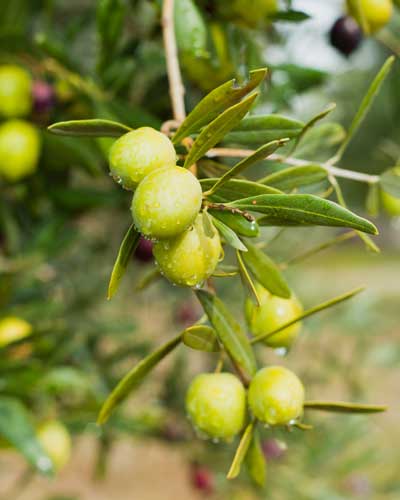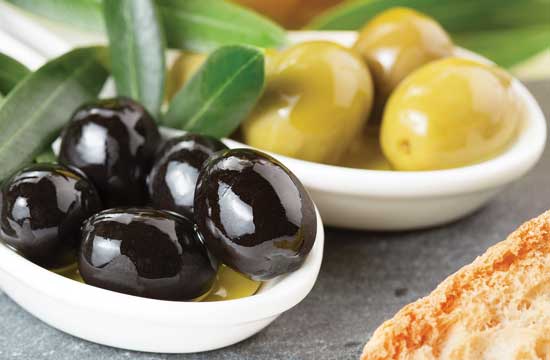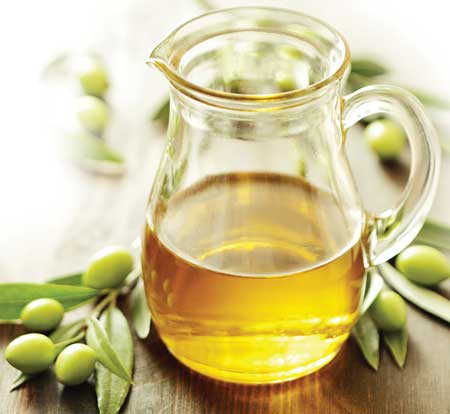Putting Olives on the Table
FOOD SAFETY AND QUALITY
The olive tree (Olea europaea L.) has been cultivated around the world for more than 6,000 years. Originating in the countries around the Mediterranean Sea, it spread throughout Africa and eventually to the Americas and Australia. It is grown in 30 countries around the world, according to the International Olive Council (IOC). Its fruit is used primarily for producing olive oil but is also consumed as table olives. Of the approximately 10 million metric tons of olives produced every year, about 90% are used for the production of olive oil, and the remainder are processed as table olives.
 Harvesting and Production
Harvesting and Production
Olive trees are alternate or biennial bearing trees, producing a large crop one year and a smaller one the next. Olives mature in the summer and are harvested in the fall, either by hand or mechanically. They are then washed to remove dirt, leaves, and twigs and sent to the processing plant, where they are sorted and graded, then processed.
Many varieties of olives are grown throughout the world. Spain is the world’s largest producer and exporter of olives, followed most closely by Italy and Greece. California produces more than 95% of the olives grown in the United States and exports and imports olives. Varieties grown in California include Manzanillo, Sevillano, Mission, Ascolano, and Barouni. Olives are also grown in Arizona, Florida, Georgia, Hawaii, New Mexico, Oregon, and Texas. According to the California Olive Committee, 70%–80% of ripe olives consumed in the United States come from California. More than 90% of the California crop is processed as black ripe olives, and the rest is processed into various specialty styles or crushed for production of olive oil.
Franciscan missionaries from Spain planted the first olive trees in California at the Mission San Diego de Alcala in 1769 with the intention of producing oil. By 1823, olive trees were being grown at 21 missions. In the late 1800s, Freda Ehmann and her son Edwin experimented with new ways to market olives, utilizing a commercial process that University of California, Berkeley professor Eugene Hilgard developed for producing and canning ripe olives.
Olives contain a bitter, water-soluble phenolic compound called oleuropein, making them too bitter to eat without undergoing a fermentation or curing process to remove it. Table olives in the marketplace come in many shapes, colors, and flavors, created by combining olive varieties with different curing processes. Familiar varieties utilized are Sevillano (also known as Gordal or Spanish Queen), Kalamata, Castelvetrano, Cerignola, Nyon, Niçoise, Liguria or Taggiasca, Gaeta, Picholine, Alfonso, Mission, Manzanillo/Manzanilla, Beldi, Morocco, Ascolano, Barouni, and Amfissa. Four main curing methods—lye curing, water curing, brine curing, and dry curing—are used to produce the primary types of table olives.
Spanish-style green olives are produced by lye curing and fermentation. Unripe (green) olives are placed in a dilute aqueous solution of sodium hydroxide (2%–4%) for 8–10 hours to hydrolyze the oleuropein. They are then rinsed one or more times with water and transferred to fermenting vessels containing an 8%–12% sodium chloride brine, which is changed regularly. Fermentation in the brine over a three-month period occurs by the action of lactic acid bacteria and yeast naturally present on the olives. The olives are then packed in brine in bottles or cans, which are hermetically sealed and pasteurized. Citric acid may be added in the final processing stage to provide microbial stability. About 60% of the world’s table olives are produced by this method.
 Sicilian-style green olives are produced by water or brine curing. The process is similar to the process for Spanish-style green olives, but no lye treatment is used. Unripened olives are placed directly into water or brine, where natural fermentation takes place. The salt concentration is increased every two to three weeks. Then the olives are rinsed with water, sorted by size, and packed into jars containing brine. Although heat treatment is not necessary, it is common to pasteurize the jars to prevent secondary fermentation.
Sicilian-style green olives are produced by water or brine curing. The process is similar to the process for Spanish-style green olives, but no lye treatment is used. Unripened olives are placed directly into water or brine, where natural fermentation takes place. The salt concentration is increased every two to three weeks. Then the olives are rinsed with water, sorted by size, and packed into jars containing brine. Although heat treatment is not necessary, it is common to pasteurize the jars to prevent secondary fermentation.
Greek-style ripe black olives are produced by brine curing or dry curing. Ripe olives are placed in brine and fermented. There is no lye treatment. A variation is dry curing, in which ripe olives are washed and packed in salt for a month or longer, which draws out the moisture, shriveling the olives. After curing, during which some fermentation occurs, the olives are rinsed with water and allowed to dry. Dry-cured olives that get softened in olive oil for several months are referred to as oil-cured.
Kalamata-style olives and Mediterranean-style cracked olives are produced by water or brine curing. Kalamata-style olives begin with naturally black ripe olives, and Mediterranean-style cracked olives with green ripe olives. Both are packed in brine after curing.
California-style ripe olives are produced by lye curing. Green olives are put into a sodium hydroxide solution to remove the oleuropein, followed by a series of cold-water rinses. The method can be used to produce both black ripe and green ripe olives. For the production of black ripe olives, air is constantly bubbled through the olives, oxidizing them and producing the black color throughout the olive; ferrous gluconate is sometimes added at the end to fix the color. For the production of green ripe olives, the same process is used without the use of air and iron. For both types, the olives cure for about one week and then are sorted to remove soft, off-color, or broken olives. They are then either further processed or sent directly to the canning lines, where they are placed into cans in a mild salt brine solution. The cans are hermetically sealed and heat sterilized. Further processing of California-style ripe olives and Spanish-style green olives before canning or bottling may involve pitting, slicing, dicing, or chopping. Pitted Spanish-style green olives are also often stuffed with pimiento, anchovy, jalapeño, or other filling.
--- PAGE BREAK ---
 Quality
Quality
The Codex Alimentarius Commission revised its international standard for table olives in 2013 to harmonize provisions with the standard established by the IOC. The minimum sodium chloride content is 5% for treated olives and higher for other types of olives (6% for natural olives and 8% for dried olives). The minimum salt content for pasteurized treated and natural olives is governed by good manufacturing practices. Since the olives are pasteurized, the salt content in the brine should be less than for table olives that are not heat treated. Types of defects are skin defects (blistering, blemishes, green stains, yeast spots, sloughing), flesh defects (gas pockets, softening, darkening, shriveling), unpleasant odors, and cloudy brine.
In the United States, the Agricultural Marketing Service (AMS) of the U.S. Dept. of Agriculture inspects olives as they are received at the processing plants to ensure that sizing and variety requirements are met and after the curing step and during canning to verify that every lot meets quality requirements for size, color, flavor, and texture. The Agricultural Marketing Agreement Act of 1937 provided a means for commodities to be created under a federal marketing order. The federal marketing order for California ripe olives and inspections of the olives did not start until the creation of the California Olive Committee in 1965, which provided a level playing field and consistent standard for both domestic and imported ripe olives sold in the United States. The act requires imported olives to meet the same or comparable grade, size, quality, and maturity standards as domestic products covered by federal marketing orders. The AMS requires inspection and certification of shipments of 100 pounds or more of imported olives—canned ripe olives prior to importation, and bulk olives for processing into canned ripe olives prior to canning—to meet minimum size and quality requirements. The AMS has color standards for canned black ripe olives imported into the United States but not for imported canned green ripe olives.
The AMS has established grades and standards for green ripe olives and canned black ripe olives. U.S. Grade A (or U.S. Fancy) green olives (whole, pitted, stuffed, halved, and sliced green olives) must have similar varietal characteristics, normal flavor and odor, and good color; be practically uniform in size; be practically free of defects; have good character (e.g., firmness); and score not less than 90 points on the AMS scoring system. U.S. Grade B (or U.S. Choice) olives must score no less than 80 points; U.S. Grade C (or U.S. Standard) must score no less than 70 points; and substandard olives are those that fail to meet U.S. Grade C. The grades are the same for canned ripe olives, with certain exceptions related to size.
Olives are marketed in the United States in various sizes. The California Olive Committee uses the following size designations for canned whole ripe olives, based on the number of olives per pound: undersize (≥ 226), sub-petite (181–225), petite (141–180), small (128–140), medium (106–127), large (91–105), extra large (65–90), jumbo (47–60), colossal (33-46), and super colossal (< 32). In July 2016 the AMS issued an interim rule implementing a recommendation from the California Olive Committee to suspend the incoming size-grade authority under the marketing order regulating the handling of olives in California. The suspension allows the committee time to evaluate new technologies such as optical sorting to improve sizing. The AMS is reviewing the comments received and will prepare a final regulation.
Promoting the Olive Industry
The International Olive Council (IOC) is the world’s only international intergovernmental organization for olive oil and table olives. Established in Spain in 1959 under the auspices of the United Nations, it was initially known as the International Olive Oil Council (IOOC) until 2006. Its members include the leading international producers and exporters of olive oil and table olives. IOC producer members account for 98% of world olive production and are located primarily in the Mediterranean region. The IOC recommends standards for the physical, chemical, and organoleptic characteristics of olive oils and table olives and the harmonization of methods of analysis. It provides guides for industry, recommends chemical and sensory testing methods, provides a proficiency testing service, offers courses and technical assistance, and publishes a glossary of key terms used most frequently in the five official languages of the IOC (Arabic, English, French, Italian, and Spanish).
The California Olive Committee is composed of table olive growers and canners, including two canneries in California: Bell-Carter Foods Inc., Corning, Calif. (bellcarter.com) and Musco Family Olive Co., Tracy, Calif. (olives.com). The committee administers the U.S. Dept. of Agriculture’s marketing order programs for black and green canned ripe olives. Each year, the California olive industry funds research conducted by the University of California and others on various issues affecting olive production.
The UC Davis Olive Center is a self-funded university-industry coalition that seeks to do for olives what the University of California, Davis did for wine. The center brings together nearly 60 university faculty members, research specialists, and farm advisors who address the research and education needs of California olive growers and processors. The center also collaborates with institutions worldwide and issues publications on olive growing and processing.
 Neil H. Mermelstein, IFT Fellow, Editor Emeritus of Food Technology
Neil H. Mermelstein, IFT Fellow, Editor Emeritus of Food Technology
[email protected]


